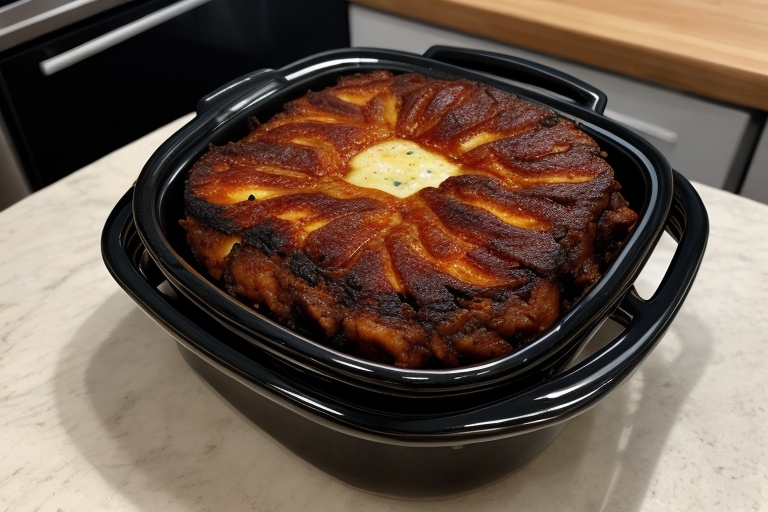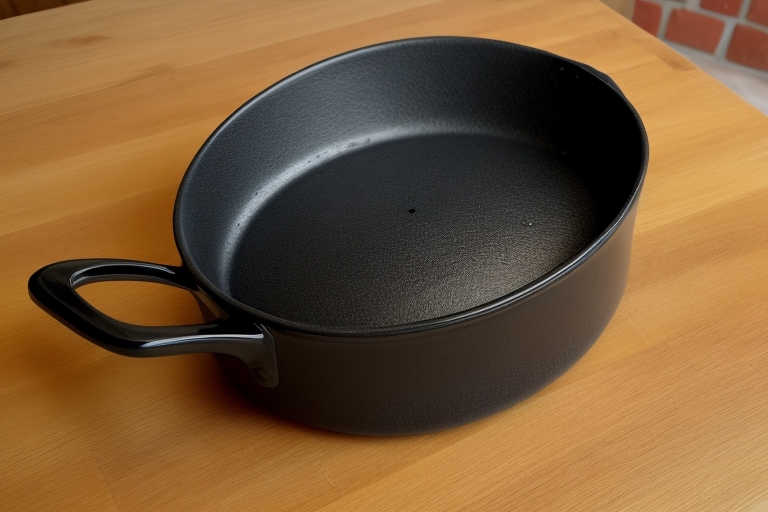
Cleaning a burnt casserole dish can be a bit tricky, but here’s a method that might help:
- Soak it: Fill the casserole dish with warm water and add a few drops of dish soap. Let it soak for a few hours or overnight. This helps to loosen the burnt-on food.
- Scrub with Baking Soda: Sprinkle baking soda over the burnt areas. Then, dampen a sponge or scrub brush and scrub the dish. Baking soda is abrasive enough to help remove the burnt bits without scratching the dish.
- Vinegar Soak: If the baking soda alone isn’t doing the trick, create a mixture of equal parts vinegar and water. Let it soak in the dish for a few hours. The acid in the vinegar can help break down the burnt residue.
- Boiling Water: For stubborn spots, you can try boiling water in the casserole dish. This can help loosen the burnt-on food. After boiling, let it cool slightly, and then use a spatula or scraper to gently lift off the residue.
- Use a Commercial Cleaner: If all else fails, you can try a commercial oven cleaner. Follow the product instructions carefully and use in a well-ventilated area.
Remember to be gentle, especially if your casserole dish is made of delicate material. Patience and a little elbow grease should do the trick!
Understanding the Severity of the Burnt Casserole Dish
Understanding the severity of the burnt casserole dish is crucial for selecting the most effective cleaning method. Here’s a breakdown of the different levels of burnt food and the associated challenges:
Light Burn:
Description: Surface-level browning or slight charring on the top layer of the casserole. Challenges:
- Minimal penetration of burnt material.
- Generally, easy to clean with basic soaking and scrubbing.
Cleaning Tips:
- Soak in warm, soapy water to loosen the burnt residue.
- Use a gentle abrasive like baking soda to scrub away the light burn.
- Regular dish soap and a non-abrasive sponge may be sufficient.
Moderate Burn:
Description: Deeper browning or charring, possibly affecting multiple layers of the casserole. Challenges:
- Increased adhesion of burnt material.
- Requires more effort to remove burnt-on food.
- Soaking time may need to be extended.
Cleaning Tips:
- Longer soaking time, possibly overnight, using warm water and dish soap.
- Baking soda or a mixture of equal parts vinegar and water for added cleaning power.
- Use a scrub brush or scraper for more effective removal.
Heavy Burn:
Description: Severe charring, possibly reaching the edges or bottom of the casserole dish. Challenges:
- Stubborn burnt-on residue that may require intense cleaning methods.
- Risk of damaging the dish if aggressive cleaning techniques are used.
Cleaning Tips:
- Soak for an extended period, possibly 24 hours, with added cleaning agents like baking soda or vinegar.
- Boiling water method, combined with scraping, for initial removal.
- Consider commercial oven cleaners, following safety guidelines.
Assessing Severity:
- Visual Inspection: Examine the degree of discoloration and charring on the casserole dish’s surface.
- Texture Test: Feel the surface for roughness or uneven areas caused by burnt-on food.
- Smell: A strong, lingering burnt odor indicates a more severe burn.
- Residue Adhesion: Check how firmly the burnt material is attached to the dish.
Note: Always consider the material of the casserole dish (e.g., glass, ceramic, metal) to avoid using cleaning methods that could damage it.
Assessing the severity of the burnt casserole dish helps tailor your cleaning approach, ensuring effective removal of burnt-on food without compromising the integrity of the dish.
Effective Cleaning Methods for Burnt Casserole Dishes

Let’s dive into effective cleaning methods for burnt casserole dishes:
Lightly Burnt Casserole Dish:
- Soaking:
- Fill the casserole dish with warm water.
- Add a few drops of dish soap.
- Let it soak for at least 1-2 hours.
- Scrubbing with Baking Soda:
- Sprinkle baking soda over the burnt areas.
- Dampen a non-abrasive sponge or soft cloth.
- Gently scrub the dish in circular motions.
- Rinse and Assess:
- Rinse the casserole dish thoroughly with water.
- Check for any remaining burnt residue.
- If needed, repeat the soaking and scrubbing process.
- Final Rinse:
- Rinse the dish once again to remove any remaining cleaning agents.
- Dry with a clean towel.
Using Natural Cleaning Agents:
- Baking Soda:
- Acts as a gentle abrasive to lift burnt-on food.
- Safe for most casserole dish materials.
- Vinegar or Lemon Juice:
- Mix equal parts water and vinegar or lemon juice.
- Soak the dish to leverage the acidic properties for breaking down burnt residue.
Heavily Burnt Casserole Dish:
- Extended Soaking:
- Fill the dish with warm water and dish soap.
- Add 1 cup of baking soda or a cup of vinegar for extra cleaning power.
- Let it soak for 24 hours.
- Boiling Water Method:
- Boil water separately and pour it into the casserole dish.
- Let it sit for a few hours to soften burnt-on food.
- Use a spatula or scraper to lift off the residue.
- Commercial Cleaner (if necessary):
- Consider using a specialized oven cleaner for stubborn burns.
- Follow the product’s instructions carefully.
- Ensure proper ventilation during use.
- Avoid Abrasive Tools:
- Use non-abrasive tools like soft sponges or brushes to prevent scratching.
- Steer clear of metal scouring pads, as they can damage the casserole dish.
Remember to always check the manufacturer’s guidelines for your specific casserole dish material, as some materials may require extra care. Regular maintenance, like avoiding prolonged exposure to high heat or using cooking sprays, can also help prevent future burnt-on food incidents.
Preventive Measures to Avoid Burnt Casserole Dishes
Preventing burnt casserole dishes involves a combination of careful cooking practices and regular maintenance. Here are some tips:
Cooking Practices:
- Appropriate Cooking Temperatures:
- Preheat your oven to the recommended temperature before placing the casserole dish inside.
- Follow recipe instructions for cooking temperatures to avoid undercooking or burning.
- Monitoring Cooking Times:
- Set a timer to regularly check the casserole’s progress.
- Avoid leaving the dish unattended, especially during the final stages of cooking.
- Properly Sized Baking Dish:
- Use a casserole dish that matches the recipe’s recommended size.
- Overcrowding can lead to uneven cooking and potential burning.
Creating a Protective Barrier:
- Cooking Sprays:
- Use cooking sprays with a non-stick formula to coat the casserole dish lightly.
- This helps prevent food from sticking and makes cleaning easier.
- Parchment Paper:
- Line the casserole dish with parchment paper before adding ingredients.
- It creates a barrier between the food and the dish, minimizing the risk of sticking and burning.
- Aluminum Foil:
- Cover the casserole dish with aluminum foil during cooking.
- This can help regulate heat and prevent excessive browning.
Regular Maintenance and Cleaning:
- Pre-Cooking Preparation:
- Wipe the inside of the casserole dish with a small amount of cooking oil before adding ingredients.
- This can create an additional non-stick layer.
- Immediate Cleaning:
- Clean the casserole dish promptly after use.
- Soak it in warm, soapy water to loosen any stuck-on food.
- Avoid High Heat for Prolonged Periods:
- Limit exposure to high temperatures for extended periods.
- Excessive heat can lead to more challenging cleaning situations.
- Non-Abrasive Cleaning Tools:
- Use soft sponges or brushes for regular cleaning.
- Avoid harsh abrasives that can damage the dish’s surface.
By implementing these preventive measures, you can reduce the likelihood of burnt casserole dishes and make the cleaning process more manageable. Consistent attention to cooking details and maintenance routines contributes to the longevity of your cookware and the quality of your meals.
FAQs
- How do I start cleaning a burnt casserole dish?
- Start by letting the dish cool down to avoid burns.
- Fill it with warm water and a few drops of dish soap.
- What if the burnt residue is stubborn?
- Soak the dish in a mixture of baking soda and water.
- For tougher stains, add vinegar to the baking soda paste.
- Can I use steel wool or abrasive pads?
- Avoid using steel wool, as it can scratch the dish.
- Opt for a soft sponge or non-abrasive scrubber.
- Are there natural cleaning alternatives?
- Yes, try a mixture of lemon juice and baking soda.
- Boil water with lemon slices in the dish for a natural clean.
- Any tips to prevent future burns?
- Use cooking sprays or line the dish with parchment paper.
- Monitor cooking times and temperatures to prevent overcooking.

Pingback: Can You Cook In A Casserole Dish?
Pingback: Why Is My Canary Sitting In His Food Dish?
Pingback: Can Casserole Dish Go In Oven?